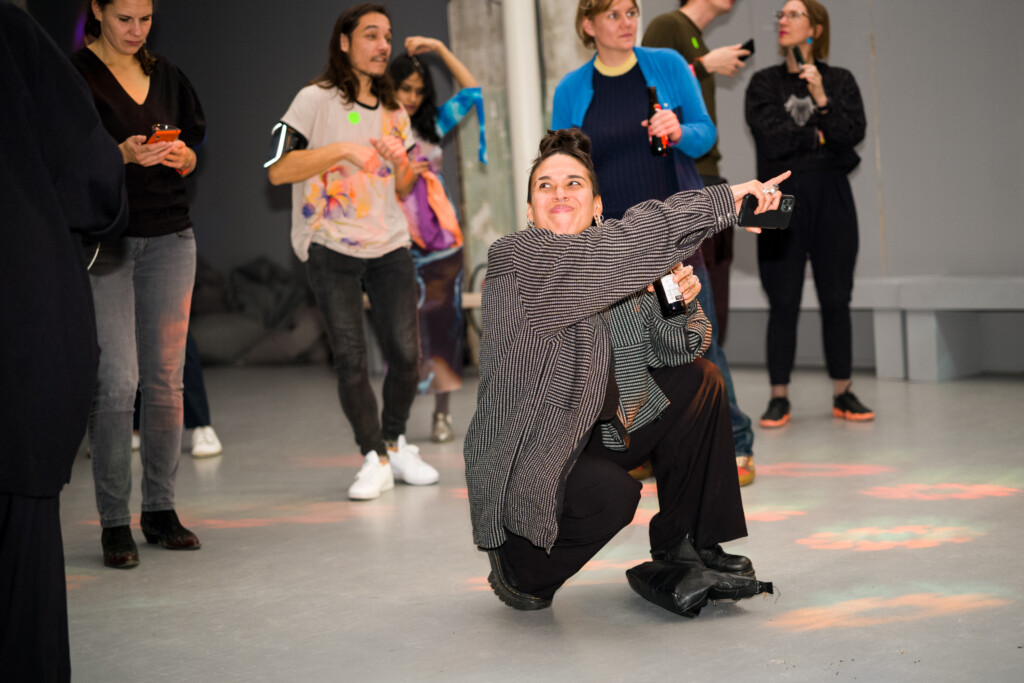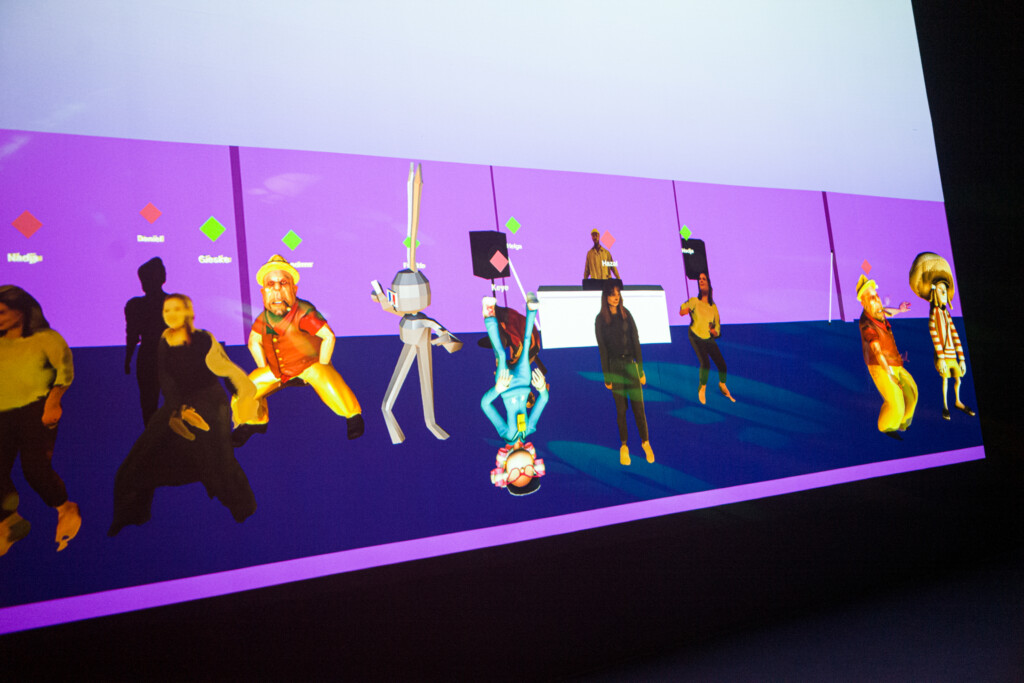MAIN TAKEAWAYS
- Creating inclusive metaverses
- Finding equality between online and on-site audiences
- The significance of recognising yourself in a digital space
- The metaverse as a mediator for in-person connections
How can we create multiplicious and inclusive metaverses?
What role can metaverses play in bringing together online and on-site audiences at a hybrid event? Together, the Toolkit for the Inbetween created the Metaverses Cha-Cha-Cha dance party, through which we aim to address these research questions.
The virtual dance floor at the centre of the Metaverses Cha-Cha-Cha is the creation of creative technologist Babusi Nyoni, whose work focuses on centring people who have been historically marginalised in tech spaces. He aspired to create a decentralised version of the metaverse, using AI and web-based tools for 3D modelling.
One of the aims of this experiment is to help people to understand that they could actively participate in the metaverse.
In the weeks leading up to the event, our guests are invited to create their own avatar at one of our in-person or online avatar workshops, or via this 4-step guide to building your own avatar.
The workshops allowed people to learn how to create their own avatar in Mixamo, using just a photo of themselves. They showed that it was relatively easy to build your own character – you just needed a phone and access to a computer. All of the software that we used in the workshop was available for free online. We ran on-site workshops in Amsterdam and Eindhoven. By making a workshop like this hybrid, we also invited audiences who might not be able to attend on-site to join in.
During its first edition, we invited the public to join on-site or online during Dutch Design week 2022. The online and on-site audience are connected via a virtual dance floor, where you can see the avatars of both audiences together. The audience then dances with their phone in their hand or strapped to their arm or ankle, and as the velocity with which they move dictates the speed at which the avatar dances. You also see on the screen that if you dance in the same rhythm as someone else, you are notified that you are in sync with that person.
Our guests can see their avatar on the screen dancing along with them – or, in some cases, twerking uncontrollably. For all of the passers-by who joined our event on-site randomly-generated avatars were provided, sparking humorous reactions.
Our Metaverses Cha-Cha-Cha dance parties are both an experiment and an opportunity for participants to learn what it’s like to build and play with their own avatar and engage with different ways of being and moving in the metaverse. But they are also an opportunity for us to explore hybridity and understand what factors result in fun, interactive and truly connecting events.
Equal Experience
One part of making these events inclusive is trying to make the event as valuable for online and onsite audiences. In our experiment, the virtual dance floor takes on a moderator/facilitator function and puts the online and onsite audiences in the same virtual space. They are, therefore, united in the experience by the virtual space.

Recognition
Central to Babusi’s design of the metaverse experience was that he wanted the audience to feel like the avatars they saw on screen were a representation of themselves. We found that for many people, it was exciting to see themselves represented on the virtual dance floor. Being able to recognise themselves and others was incredibly valuable to our audience.
That being said, being unrecognisable is historically a key feature of virtual spaces. For some of our guests, this importance still prevails. Using randomly assigned avatars can also provide a degree of anonymity. Providing anonymity for online audiences is important, and doesn’t prevent them from forming a connection to other people at the event. Additionally we found that not having a recognisable avatar did not stop people from feeling ownership over their character, as they were still dictating how it moved.
Agency
Being a member of the audience at any event, but especially online, can be a very passive experience. Our experiments test how hybridity and technology can enable the audience, on-site and online to become active participants.
In the case of the Metaverses party, this meant enabling the audience to influence what they see on the screen. We wanted to find out whether participants felt that the avatar influenced their movements or they influenced the avatars movements. Some felt the strange movements of the avatar gave them freedom to move more freely. Others felt the movements of the avatar didn’t represent them, impeding the connection they felt to the avatar.
Connecting via the Metaverse
We are still investigating the challenge of creating a deep connection between online and on-site audiences. We think that recognition – feeling represented at the event, and recognising others, and being able to identify who is online and who is on-site – is definitely a factor that can help the audiences to feel connected to each other.
From our interviews we learnt that participants expressed a desire to form a connection with other on-site participants, but they referred to their attempts to do this via the metaverse. Instead of turning to the person next to them on-site, they tried to connect via their avatar to someone else’s avatar through the syncing function, for example.
Connecting with your(digital)self
Despite being at a party surrounded by real people, individuals were often focussing on trying to connect to their avatar, which is a digital representation of them-self. They fixated on trying to get their avatar to move in a specific way or mimicking the way it moved, becoming entirely obsessed with their avatar.
